1
The first european land owners to the Parrsborough shore came after the American revolution as British Loyalists and Planters. One of the first families was Nathanial Hughes who migrated to Diligent River from Dartmouth. They worked the land and put their carpentry skills to use in the shipyards. Other families came to the area and took up work in the shipyards or bought tracts of land and started lumber camps like the McQuarters of Appleriver.
2
Loyalist Settlers
Circa 1812
Port Greville, N.S.
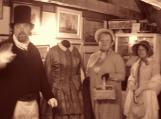 Credits:
Credits:
Age of Sail Heritage Center
3
Tools 2
1900
Port Greville, N.S.
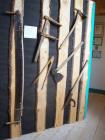 Credits:
Credits:
Age of Sail Heritage Center
4
In the woods and camps the labor was hard and equipment primative. The Ax men used their broadax or sometimes the sawyers used a 2 man crosscut saw to fell the trees. Then the tree was bucked, or cut into lengths to be hauled out. The adze and broadax were used to hew(square off) the timbers. A peavy turned the logs in the water and an auger drilled a hole. Other tools like rip saws and bow saws, drawknives and planes were used in working the wood.
5
tools 3
1900
Port Greville, N.S.
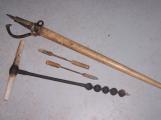 Credits:
Credits:
Age of Sail heritage Center
6
The pit saw was a 2 man rip saw used to saw logs into boards. The log was supported on two joists or scaffold over a deep pit with one man in the pit and the sawyer on the log. The sawyer pushes the saw and the weight of it does most of the work the lower man or pitman,only supports and guides the saw to keep it perpendicular. The pitman was usually the youngest or newest man to the lumber yard who quickly learnt to wear a wide brim hat to keep sawdust out of the back of his shirt and hopefully his face!
7
Pit Saw
1800-1900
Port Greville, N.S.
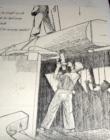 Credits:
Credits:
Age of Sail Heritage Center
8
The logs were often transported to the lumber mills by floating down the river. Sometimes too many logs at a narrow spot on the river could result in a log jam which could prove to be dangerous for the men who had to move the logs and get them flowing again. This is where your peavy and gaff were used.
9
lumbering
1880-1930
Red River, N.S.
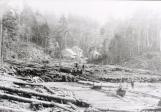 Credits:
Credits:
Age of Sail Heritage Center
10
Lumber camp
1885
Red River, N.S.
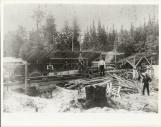 Credits:
Credits:
Age of Sail Heritage Center
11
The lumber camps were a beehive of activity. Their were bunk houses for the workers, wash houses to clean up, cookhouses for the cooking and eating, stables for the horses and of course the working areas for the lumber. Workers worked 6 days a week from 5:30am to4:30, no indoor plumbing, straw mattresses and living far from any homes or family for perhaps $.50 or a doller a day. It was a way of life for many and a reasonably good life at that.
12
Camp Life
1920's
Red River, N.S.
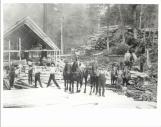 Credits:
Credits:
Age of Sail Heritage Center